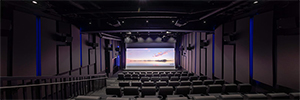Meyer Sound aporta con MAPP 3D nuevas dimensiones al diseño de sistemas de sonido
La herramienta MAPP 3D de Meyer Sound aporta renderizados tridimensionales muy precisos del rendimiento previsto del sistema de sonido, dentro de los planos detallados del recinto.
MAPP 3D supone la actualización más amplia de la herramienta de diseño de sistemas de Meyer Sound, convertida en estándar de la industria desde que se introdujo el programa de software original MAPP Online en 2001. Disponible para su descarga gratuita en la web del fabricante, funciona para Mac y Windows y emplea procesamiento local (no requiere conexión a Internet).
Esta herramienta proporciona renderizados tridimensionales muy precisos del rendimiento previsto del sistema de sonido dentro de los planos detallados del recinto. MAPP 3D ofrece una integración completa con los procesadores Galaxy y el software de control Compass, para un flujo de trabajo completo desde el diseño inicial hasta el ajuste in situ.
Los parámetros de procesamiento integrales para sistemas complejos se pueden optimizar utilizando las predicciones MAPP 3D, con la configuración resultante del procesador, guiada directamente a múltiples procesadores Galaxy con el clic de un ratón.
Gran precisión
Además de las pruebas de calibración tradicionales de las fuentes de señal, MAPP 3D es compatible con M-Noise, un estándar emergente de la industria para determinar el máximo SPL lineal para la música. Esta combinación proporciona la predicción más precisa hasta ahora de la capacidad máxima que tiene un sistema de sonido al reproducir música.
Como explica Perrin Meyer, director de tecnologías emergentes de Meyer Sound, “el lanzamiento de MAPP 3D marca un hito en el desarrollo de software de diseño de sistemas de sonido, no sólo para la compañía, sino para la industria en su conjunto. Los detalles en las representaciones son espectaculares y la flexibilidad de la interfaz de usuario no tiene precedentes”.
El diferencial de esta actualización, como señala Meyer, “es la extrema precisión de las predicciones. Lo que se mide con los micrófonos virtuales de MAPP 3D es exactamente lo que se verá en las mediciones de los micrófonos reales”.
La combinación de una interfaz simplificada y fácil de usar, la integración perfecta con los procesadores Galaxy y la fácil importación de archivos SketchUp (SKP) y AutoCAD (DXF) aporta un ahorro significativo de tiempo y costes, tanto en el diseño del sistema como en la optimización in situ.
Con múltiples vistas y una herramienta de control de rotación libre, las áreas de audiencia se pueden definir rápidamente, incluso dentro de una arquitectura compleja. Los line array se pueden configurar de manera rápida y automática para una cobertura uniforme, así como evaluar simultáneamente múltiples opciones de sistema.
Configuración y predicciones
Además, MAPP 3D permite a los diseñadores realizar la optimización virtual del sistema en la fase de diseño. Incluye procesadores de señal virtuales Galaxy, de manera que el diseñador puede agregar y configurar procesadores, ver los resultados de la predicción y, posteriormente, sincronizar estos ajustes directamente a los procesadores de hardware en el sitio.
También están disponibles funciones completas de procesamiento de salida de todos los modelos del procesador Galaxy, y la función de ‘copiar y pegar’ se puede utilizar para replicar ajustes en uno o más canales de procesamiento.
Debido a que MAPP 3D incluye datos precisos de sensibilidad para todos los altavoces de sonido Meyer Sound es posible mostrar predicciones como el SPL del mundo real, así como atenuación.
La incorporación de la sensibilidad junto con la compatibilidad M-Noise también proporciona predicciones muy precisas del Headroom del sistema, lo que evita la tendencia al sobredimensionado del diseño de los sistemas y redunda en una mayor eficiencia de costes.
El rendimiento de los altavoces MAPP 3D se basa en más de 65.000 puntos de medición tridimensionales, tomados en una resolución de 1/48 de octava en la cámara anecoica de Meyer Sound.
Además, las predicciones en 3D de MAPP son certeras en el ancho de banda de todos los altavoces, incluyendo hasta 12,5 Hz para el elemento de control de muy baja frecuencia del VLFC.
Uniformidad de rendimiento
MAPP 3D también aprovecha las ventajas inherentes de trabajar con altavoces autoamplificados y fabricados con tolerancias extremadamente estrictas para la uniformidad de rendimiento.
“Al trabajar con predicciones en MAPP 3D, puede estar seguro de que los altavoces virtuales se comportarán exactamente igual que los modelos físicos probados en la cámara anecoica -subraya Todd Meier, director de gestión de productos de Meyer Sound-, al igual que los altavoces en el sistema instalado final”.
Otra de las ventajas es que “la autoamplificación elimina las variables asociadas con la alimentación externa, como el tipo de amplificador, la configuración de salida de este y la longitud del cable del altavoz; lo que añade complejidad e introduce una posibilidad de error en otras herramientas de predicción”, asegura Meier.
Los gráficos actualizados de alta resolución y la interfaz de usuario flexible en MAPP 3D proporcionan gran variedad de opciones para el diseño y el análisis del rendimiento. Los diseñadores del sistema pueden insertar simples geometrías 3D para conocer el comportamiento de la matriz fuera del área de audiencia.
Las capas se pueden activar y desactivar para acelerar el flujo de trabajo. Los planos de predicción se crean rápidamente a partir de dibujos importados con la herramienta Snapping.
Además, también es posible crear rápidamente múltiples planos de predicción en grandes espacios con secciones simétricas, utilizando la extrusión lineal y angular en combinación, con las herramientas Mirror y Align.
Te gustó este artículo?
Suscríbete a nuestro RSS feed y no te perderás nada.



















